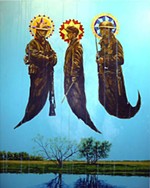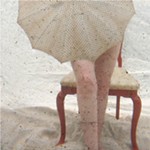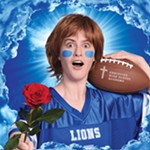‘Lu Ann Barrow's Soul-Journers: Friends, Family, and the Fabric of Daily Life’
In Lu Ann Barrow's brilliantly colored canvases, every pebble, blade of grass, dress, and wallpaper pattern is rendered in bold colors that excite rather than drown one another out
Reviewed by Nikki Moore, Fri., Oct. 6, 2006

"Lu Ann Barrow's 'Soul-Journers': Friends, Family, and the Fabric of Daily Life"
Austin Museum of Art – Downtown, through Nov. 5
If you have ever watched any of the bonus material tacked at the end of a Pixar DVD, you've had a glimpse into the complicated world of digital art. I was particularly drawn in by a lengthy bonus piece on The Incredibles DVD. Apparently one of the most difficult parts of that computer-animated film was making one of the lead character's long hair look real. To avoid creating just a mass of long black nothing, each hair was programmed to act independently. But this independence had some very odd results: Before they perfected the process, each individual strand of hair stood out and was distinguished from its animated environment, giving this character more of that "electrical storm" appeal than desired. Where the Pixar team wrestled with how much detail and independence a mass of hair needs to reflect in order to look real, Lu Ann Barrow's work is a testament to what happens when detail-oriented caution is thrown to the wind. Individualizing nearly every inch of her brilliantly colored canvases like wildly printed fabrics, Barrow does what an eye without the filtering power of the brain might do: She not only clarifies but highlights each blade of grass, every cobblestone, pebble, flower, dress, and wallpaper pattern, painting them in bold colors that excite rather than drown one another out. The result is like Christmas morning: With each ornament sparkling on the tree above a mound of brilliantly wrapped presents, it is difficult to decide where to look first.
Looking, however, is only part of what Austinite Lu Ann Barrow's work is about. Drawing inspiration from artists such as Henri Matisse, Barrow creates forms that are idealized and stylized. The strong influence of "primitivists" such as Henri Rousseau is evident in Barrow's flattened depths of field and her deceptively "untrained" technique. Barrow's themes are stylized as well, yet Barrow breaks away from stereotypes as she mixes locations, peoples, and lifestyles from her travels and memories into something far more imaginary than typecast or attemptingly descriptive.
In the most brilliant of her paintings, the balls on Barrow's painted chenille robes and slipcovers are so gayfully textured that you want to reach out and touch them. Yet as you nearly do, the eye-popping wallpaper steals your eye only long enough before your gaze is drawn into the almost psychedelic colors of the braided rug that unites her dancing characters to their floor. Barrow's paintings are paintings that have gone through, in the mind of their maker, abstraction, impressionism, and, as her graduate work at the University of Texas attests, all the academic genres. Yet her work, true to her roots, comes back without pretension to storytelling, to laughter, and to Texas.










